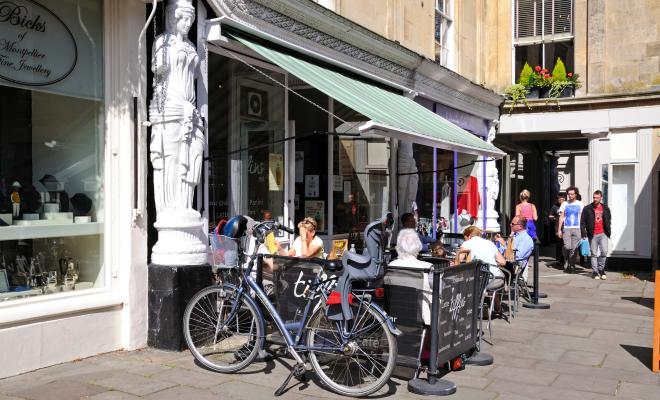28 Nov 2023
New research by Friends of the Earth and the University of Leeds, which involved a huge and complex analysis of all available local and national timetable data in England and Wales over the last 15 years, has shown that while London has had an almost constant level of bus provision, many other parts of the country have seen declines of more than two-thirds.
These cuts are likely to disproportionately impact those living on low incomes, people of colour and disabled people because they are less likely to own a car, as well as people who’ve had to give up their car due to their age or health.
Unlike the rest of Britain, London bus services weren’t deregulated in the 1980s. This means they remained a public service controlled by local government body Transport for London, which sets routes, timetables and fares. Reregulating buses and additional finance are key to delivering a much-needed bus renaissance.
What do the results show about bus cuts?
Bus services outside of London are significantly worse than they were 15 years ago. Since 2008,
- urban bus services (except London) have dropped by 48%
- rural bus services have dropped by 52%.
Use our interactive map to see how bus services have changed in your area. You can filter by neighbourhood, local authority, transport authority or Westminster constituency.
Tables 1 and 2 below show the scale of bus service reductions.
Table 1 is for the 15-year period from 2008 (when bus service provision was at a peak) to 2023. It shows, for example, that the East Midlands has suffered severe cuts in services, ranging from a 56% reduction on Sunday nights to a 65% reduction on a Saturday midday. Apart from London, every other region in England has also seen savage cuts. There have also been significant declines in bus services in Wales.
Table 2 shows the data over the period of Conservative Party rule from 2010. It shows that, while cuts to bus service provisions were started before the party came to power, the vast majority of the cuts have happened during its tenure.
Table 3 looks at data on the past and current frequency of services and compares London with rural and other urban locations. This shows how London is favoured with much better bus services, even when compared with other urban areas. It also shows the lack of bus services in rural areas, which have declined slightly more than the decline in urban areas outside of London, despite already being a much poorer service.
The data shows that during 2006-2008 London was already favoured with much better bus services than the rest of Britain, and that this situation has been cemented through severe service cuts in areas outside London over the last 15 years.
During 2006-2008, areas in London not near Underground stations had twice as many services as other urban areas, but the disparity is much greater now. Frequency has increased in these areas of London but decreased by 48% in other urban areas. The difference in service provision is further illustrated by the fact that, for the 317 local authorities outside of London, only 59 had a bus service that was more frequent during the weekday morning peak than the average London Sunday night bus service.
The research also looked at bus service provision at a local authority level, as well as at a more granular neighbourhood level, defined as Lower Layer Super Output Areas (LSOAs). The local authority data is available to download. Table 4 identifies the local authorities that have suffered the greatest cuts, with Hart, Fenland and Broxtowe topping the list.
We’ve also provided data at parliamentary constituency level, using the new constituency boundaries that’ll be used for the expected general election in 2024. For the 20 constituencies that have seen the highest proportional reductions since 2010 (Table 5), 18 are Conservative and 2 are Labour, while for the top 100, 82 are Conservative seats, 15 are Labour, 2 are Liberal Democrat and one Plaid Cymru. These results are based on voting in 2019 adjusted to the new constituency boundaries. Data for all constituencies is available to download.
Detail on the methodology deployed to carry out the analysis is available towards the end of this article.
Who fares worst from reduced bus services?
The data shows strong geographic disparities. The overall picture is that London has an established, reliable and frequent bus service throughout the week (including evening and night services). Such a service level rarely requires pre-journey timetable checking or journey planning. For most parts of the capital, buses can be expected to turn up within a short period of time throughout the week.
Outside of London however, weekday evening services (6pm-10pm) are often only at one-third or less of the weekday morning peak frequency. For those needing to travel outside of peak times, there’s a significant drop-off in the frequency and reliability of services. This particularly impacts shift workers without a car, for example those working in the NHS. It also impacts those without a car wanting to access cultural services such as restaurants and cinemas in the evenings (only 27% of young people aged 17-20 have a driving licence).
A poor bus service has the greatest effect on the day-to-day travel experience of those without access to a car. Government data identifies that 33% of Black people have no access to a car or van, compared with 16% of White people and 17% of Asian people. This data also shows disabled adults are more likely than non-disabled adults to live in households without access to a car, with 28% of disabled adults being in this position compared with 15% of non-disabled adults. Some caution is needed in interpreting the relevance of these figures for this study because, for example, London has a higher proportion of people of colour living there than other areas and public transport provision in London is good. However, it’s very likely that people of colour and disabled people living outside of London are disproportionately impacted by the savage cuts to bus provisions.
How can we fix bus services?
Transport experts Transport for Quality of Life, who published a series of briefings for Friends of the Earth in 2019, recently published an excellent report with the Trades Union Congress (TUC) called “Public transport fit for the climate emergency”. Friends of the Earth is happy to endorse the recommendations in this report.
We’re campaigning in Wales to ensure that new legislation (the Bus Bill), which will be introduced to the Senedd in 2024, delivers the quality of services needed. If the bill is in line with the White Paper consulted upon last year, which we responded to, it could be the basis of the transformational reform needed to deliver integrated, inclusive and accessible bus services that are much needed in Wales. We published an influential report with Transport for Quality of Life in July 2020 called "A Wales Transport Policy fit for the Climate Emergency," which outlined the changes needed.
Two of the most important changes to provide high-quality bus services in England and Wales are:
- More money. According to Transport for Quality of Life, by 2030 an additional operating expenditure of around £7.5 billion per year is needed, alongside £24 billion for capital expenditure until 2035 (approximately £2 billion a year). These are figures for England and Wales, and since transport is a devolved issue, the Welsh Government will need to be provided with its share. According to the National Audit Office, there was a 38% reduction in local authorities’ financial support for bus services in England outside of London between 2010-11 and 2018-19.
- Regulation. Bus services were deregulated in the 1980s with disastrous consequences. However, London was excluded from this experiment. Since then, the capital has benefited from a well-regulated public transport system and is able to manage public transport as a public service. English city regions were given the powers to regulate their buses in 2017, but only if they went through a costly and lengthy process (Greater Manchester has just managed to bring its buses back under public control). All transport authorities should be provided with the resources and powers to franchise bus services, meaning a well-regulated service becomes the norm.
We need a bus renaissance. Transport for Quality of Life says the government should aim to more than double bus passenger kilometres by 2030 (from pre-Covid levels). We support this level of ambition. Alongside this, it would be beneficial to set quality standards for bus provision in different types of locations. For example, CPRE has called for every village of 200-300 people to be guaranteed at least an hourly bus service from 6am to midnight, 7 days a week.
The social exclusion faced by those without a car must end. If we’re to meet climate goals, we also need to support people to leave their cars at home and reduce the need to own a car by proper investment in public transport.
Methodology
Data analysis has been conducted using annual snapshots of public transport timetable data between 2004 and 2023 (see below to understand why we’ve chosen to present data from 2008 onwards). For more recent years, this is available in the international General Transit Feed Specification (GTFS) format. The GTFS is an Open Standard used to distribute relevant information about transit systems to riders. It allows public transit agencies to publish their transit data in a format that can be consumed by a wide variety of software applications. For earlier years (pre-2018), the data sets needed to be transformed into the GTFS format from the various sources. The table below shows the sources of data for each year of the study period and some comments on data quality.
Once data sets for each year were transformed into the GTFS format, a program developed by the University of Leeds processed timetable data to calculate the frequency of services scheduled to stop in each LSOA and local authority in Britain, measured as “trips per hour” (TPH), for buses, trams, metros and trains for the following times of day:
- Morning peak (6-10am)
- Midday (10am-3pm)
- Afternoon peak (3-6pm)
- Evening (6-10pm)
- Night (10pm-6am)
- Daytime average (6am-10pm): weekdays only
The data suggests that the overall frequency of bus services across Britain peaked around 2008, which coincides with, although isn’t necessarily related to, the financial crash. In addition to this, some timetable data from before 2010 is incomplete for some locations, for various reasons. Reasons include missing timetable data, data not submitted by some bus operators in some years, incomplete historical archives, data inconsistencies meaning the program to extract data missed some data anomalies, and geolocations of bus stops missing or incorrect. The data for 2004 and 2005 in particular has significant gaps. To account for data concerns for individual years, and to find a baseline year from which to measure trends to 2023, the analysis therefore calculated an average annual value for TPH over the 3-year period 2006-08 for each location. Some further data clean identified and removed outlier data points for locations and imputed missing data by correlating with data either side of missing data points, for example in London for 2014 to 2017.
Finally, due to data quality issues over the time frame of the study, only bus timetable data has been included in the analysis. While the data also includes rail, metro and ferry information, this was less consistent, particularly for earlier years of the study period. As a result, this analysis has focused solely on bus services. In some locations, other modes of public transport have experienced increased capacity or new routes (notably in Greater Manchester, which has seen the deployment of a new tram network, and Central London, which has benefited from an increase in the frequency of underground services and new rail lines), which may counteract or be a reason for the reduction in bus services.




